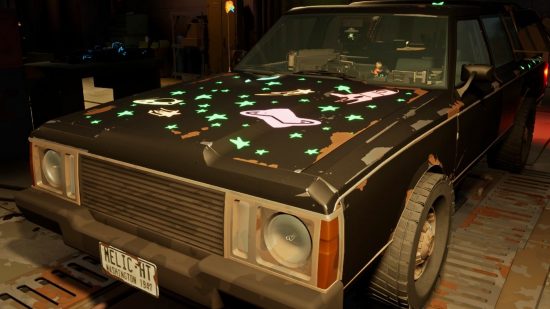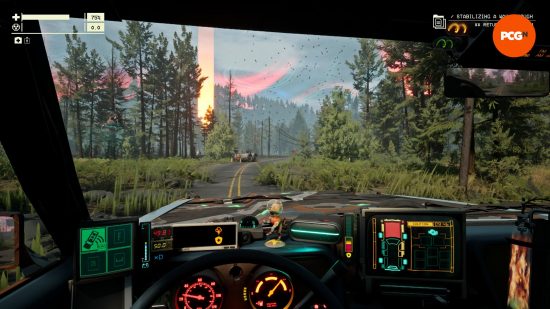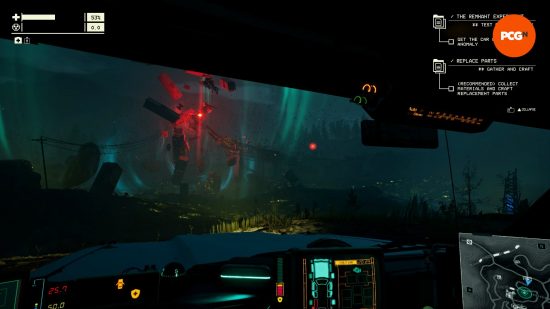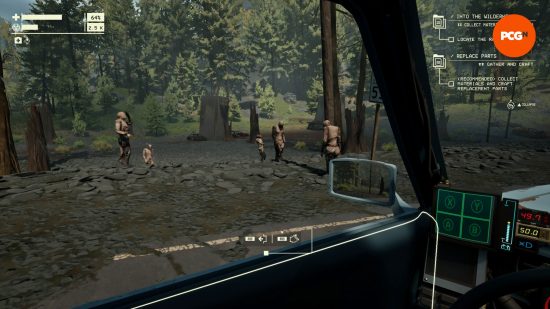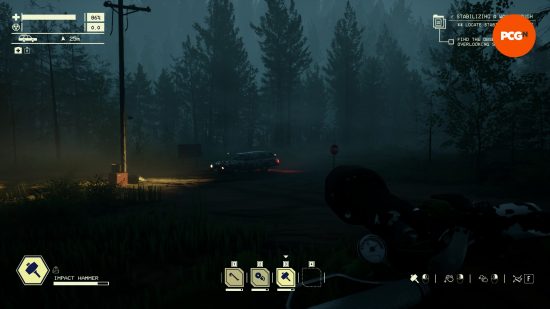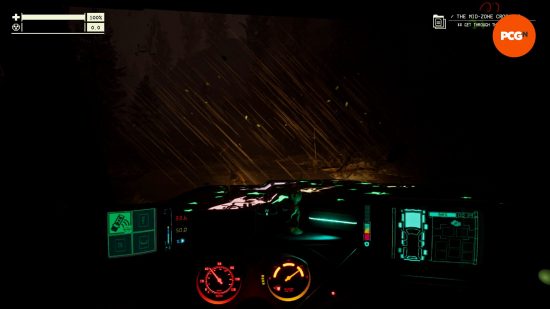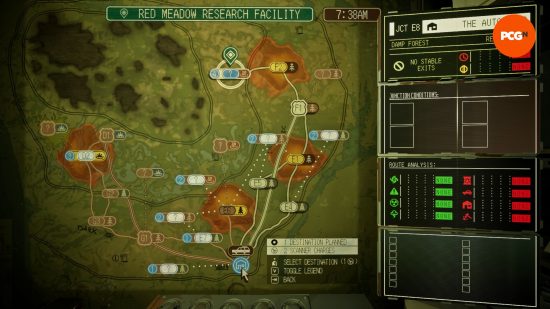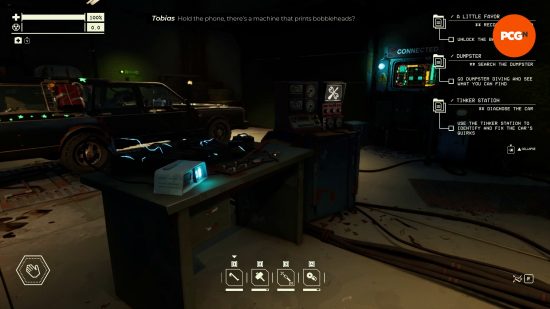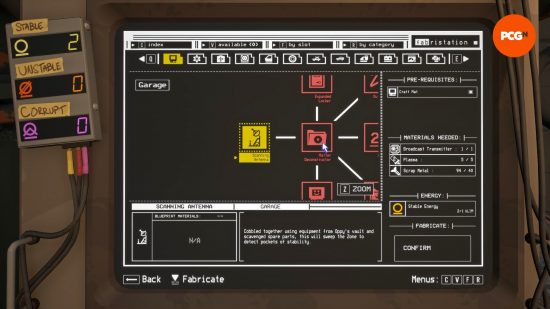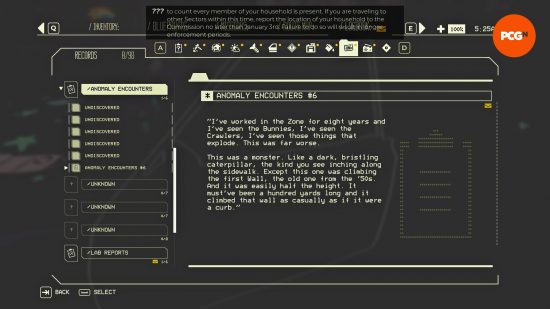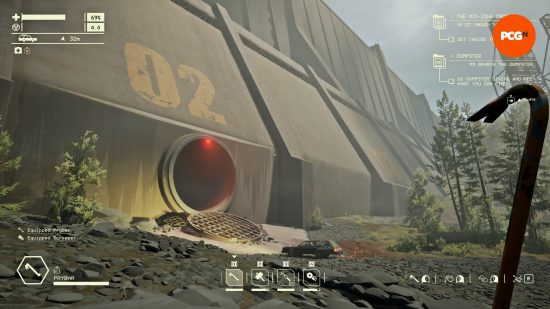Our Verdict
Pacific Drive offers a road trip like no other, boasting immaculate sound design and a classic '90s conspiracy delivered through a compact survival-crafting roguelike loop.
Since the inception of videogames, there’s been an ongoing pursuit to forge a genuine and long-lasting emotional bond between player and character. While the likes of The Last of Us and God of War chase the prestige TV script format, the search for a depth of meaning in mechanics has been undertaken elsewhere, most notably in Ico and Brothers: A Tale of Two Sons. These ongoing efforts have been met with varying degrees of success, but Pacific Drive opts to replicate a deeper, far more powerful connection: the symbiotic relationship between a driver and their car.
Set within the boundaries of a fictional US government Exclusion Zone sequestered in Washington’s vast Olympic Peninsula, Pacific Drive is a quintessential ‘90s conspiracy thriller. Its opening gambit casts me as a hapless delivery driver, transported into the Exclusion Zone by the paranormal forces within. Thankfully, I’m not alone. I’ve got a set of supernatural wheels and a radio tuned into ex-employees stranded within the Zone who are also searching for a way out.
Fans of Netflix’s Stranger Things are sure to enjoy this latest riff on the Montauk Project conspiracy theory, though Pacific Drive trades in the teenage test subjects and psychic powers for tropes befitting the New Weird movement, as popularized by Remedy’s Control and the SCP Foundation collaborative fiction project. More importantly, Ironwood Studios has also captured a very specific moment endemic to ‘90s disaster films. You know the one: a character jumps into a car to escape a deadly threat, consumed with panic and unable to drive away. They fumble with their keys and forget the very basic principles of driving a car, leaving you screaming at the screen because they just won’t hurry up. In Pacific Drive, Ironwood Studios plops you in the driver’s seat and says, “Alright then, let’s see how you handle it.”
Regretfully, I do not handle it well. In my frantic dash to escape paranormal Anomalies and debilitating storms, I frequently hit the gas without pulling the handbrake, switch off the ignition instead of the windscreen wipers, and on one memorable occasion, crash into a building not five feet in front of me. When I lay it out like this, it sounds like an exercise in frustration, but it’s not. Instead, the delicious friction between Pacific Drive’s tactility and my adrenaline creates emergent chase sequences laced with panic and amusement in equal measure.
The streak of realism running through Pacific Drive should be instantly familiar to driving simulation fans. Getting my reliable rustbucket to take me wherever I need to go isn’t as finicky as, say, Truck Simulator – its key components consist of the ignition, handbrake, and automatic transmission – but it remains highly tactile and adheres to real-world physics in much the same fashion. If I neglect to pull the handbrake on a slight incline, it’s a sure guarantee that I’ll return to find my car wedged against a rock or fence, and forgetting to switch off my headlights can burn through its battery at speed. I’m also surprised to discover that this realism also extends to myself. I forget to take a step back before I close the trunk of the car, and rather than pass harmlessly through me, it bonks me on the head with a dull thunk. The token damage it inflicts is superficial, but the revelation is stark. In Pacific Drive, I am not just a floating camera, but a fully realized person that takes up space in its world.
The Exclusion Zone exists in a constant state of flux, making it the perfect staging ground for Pacific Drive’s roguelike game elements. Each ‘run’ can last for as little as ten minutes or as long as two hours, made distinct by procedural generation. Some trips are a sedate affair, notable only for the sunny skies and docile Anomalies that leave me free to cruise down country roads and ransack abandoned buildings at my leisure. Others are a veritable dirt rally, as I battle through hurricane squalls and anomalous interferences in a race to get to the next stop on my route before I sustain any serious damage to cut my journey short. Each stop on my route is subject to weather conditions and special modifiers that I can manipulate in my favor. Pacific Drive is not a horror game, but when I’m forced to traverse through a forest smothered by an eerie darkness, pursued by something moving between the trees, it certainly feels like one.
Pacific Drive’s soundtrack has been the subject of much discussion and several Spotify playlists ahead of its release, and I’m happy to say it does not disappoint. Ironwood Studios’ music choice captures the spirit of the quintessential Pacific Northwest road trip. My car’s radio waves undulate to the tones of graveled American folk music, gossamer dream pop, and vintage rock, which can set the mood as effectively as it can dispel the tension, as I crank up the volume to drown out any unnatural sounds emanating from beyond the car’s cozy interior.
However, once I step beyond those safe confines, I’m left entirely at the mercy of the Olympic Peninsula’s otherworldly soundscape. Ironwood Studios has taken Frictional Games’ approach to sound design, in that their anomalous creatures aren’t all that terrifying to look at, but they’re positively hellish to hear. The drone of an approaching Abductor has me sprinting indoors, while the static crackle of Bunnies has me swerving prematurely to avoid their path. However, the worst are the sounds of Anomalies that I can’t see, whose inhuman shrieks and reverberating rumbles tap into a primal part of my brain that tells me to run, now. It sends a clear message without words: I do not belong here.
That reminder nips at my heels as I sprint back to the safety of my car, where I pick up the radio chatter between Oppy, Francis, and Tobias. This motley trio is the driving force behind Pacific Drive’s story. Underneath Francis’s cheery optimism, Tobias’s anxious stammering, and Oppy’s snarky pragmatism, it’s apparent that none of these people are entirely what they seem. Conversations pockmarked by government bureaucracy and workplace politics often swerve into the realm of petty accusations, unresolved conflict, and the ache of old wounds. It’s all very intriguing, but I’m often forced to disengage with it to wrestle with malfunctioning controls or fight against the inexorable pull of an Abductor’s tow rope. Sure, it’s easy to pick the narrative thread back up after I’ve dropped it, but I miss out on the intricacies of these conversations thanks to the unpredictability of the Zone itself.
With all the cryptid chaos unfolding across the Exclusion Zone, you might be wondering why you’d ever want to get out of the car in the first place. I can sum it up in a single word: supplies. If you’re feeling burnt out on survival games, don’t panic. Ironwood Studios effortlessly strips out much of the busywork that has crept into survival-crafting mechanics over the past few years. Pacific Drive’s inventory management forces me to reckon with my car’s limited storage space while out in the Exclusion Zone, juggling crafting resources alongside audio tapes, cosmetic paint, spare tires, and everything else I’ve opted to bring along in case of emergency. However, a generous item stack count means I’m never forced to spend an undue amount of time playing inventory Tetris, nor is there a deluge of non-descript stuff to parse through à la Starfield.
Instead, crafting components are visually distinct and have their place in the world. Backpacks full of clothes can often be found in abandoned residential homes, while hazmat cabinets stocked with chemicals are found almost exclusively in lab facilities. This clear-cut world logic leaves me in a better position to make decisions on my drive, rather than pulling up to every point of interest on the roadside.
Initial reports of Pacific Drive’s fast travel system elicited some raised eyebrows – this is a driving game, after all – but I find its self-contained maps and old-school route planning far more appealing than the prospect of a vast open world. This framework also means I’m not beholden to the path that NPCs set for the story. Either way, once I reach the terminus of my chosen route – or feel the need to beat a hasty retreat – I’m free to open a fast travel gateway back to the garage at any time. Thus commences a desperate race to reach it before the storm closes in, represented by the menacing blood-red sky and encroaching circle of death on my map. No matter how many trips I take, these scant few minutes are spent with my heart in my throat, praying that I can escape with my car, my inventory, and myself intact.
The garage serves as the glorified reset button to Pacific Drive’s game loop – the circuitous start and end to each trip. In this liminal space, I dote on my long-suffering iron horse, slapping great splotches of repair putty on storm-beaten panels and painstakingly replacing broken headlights. Restoring my car to its former glory can often involve stripping it right down to the chassis, but the drawn-out process of sealing up cracked windscreens and removing worn tires is both soothing and well worth the satisfaction of stepping back at the end of it all to see the fruit of my efforts: a primped and polished ride, ready to run ragged around the Exclusion Zone.
These routine pit stops are also integral to Pacific Drive’s story, as Oppy, Tobias, and Francis all tell me in no uncertain terms that my beloved station wagon has bound itself to me and planted the seed of obsession in my mind, at the eventual cost of my sanity. There’s a glimmer of Bioshock’s approach to ludic determinism in this premise, whereby the only way to resist this descent into madness is to disengage with Pacific Drive altogether. Obviously, I’m not going to do that, and so my fate is sealed.
Pacific Drive’s parody of car ownership extends to the weird little quirks that it develops over time, which can be identified and subsequently removed. Admittedly, I didn’t realize my car’s first quirk – the horn honking whenever I close the trunk – was, in fact, a quirk. Instead, I just considered it a cheeky little nod to the fact that the car isn’t just a car and that it didn’t appreciate the not-too-gentle slap on the rear. I’m not ashamed to say that I still find it so funny that I can’t bring myself to fix it – though its sudden compulsion to open the passenger door whenever I pulled the handbrake was very short-lived.
On the subject of car modifications, it’s time to talk upgrades. I find that upgrade systems in RPG games often fall foul of deliberately stripping the player down to the bare bones, just to provide something worthwhile to unlock in the first place. In this case, the base model of Pacific Drive’s car is, well, a car, and as such the upgrades feel practical and entirely justified. My summer tires struggle to find purchase on dirt roads so investing in off-road tires provides instant relief, while the frail protection that crude panels provide is entirely outclassed by its armored equivalents.
Ironwood Studios doesn’t skimp out on the cosmetics, either, and while I could slap on some hot rod red and tasteful decals for a Greased Lightning throwback, I clock the glow-in-the-dark paint and tacky UFO mirror ornament and resolve to create the Pizza Planet delivery truck of my dreams. The cartoon bobblehead of Laika the space dog propped on my dashboard nods frantically as I veer off cliffs and crash through the undergrowth, and it’s all I’ve ever wanted.
On that score, as someone prone to simulation sickness, Pacific Drive’s suite of accessibility options is a sight for (literal) sore eyes. I’m quick to dive into them to scale back the motion blur and nauseating camera bob, and I discover a cornucopia of choice for players who are visually impaired or prone to sensory overwhelm, including the facility to minimize weather effects and toggle non-diegetic HUD warnings. However, it’s patently clear that Ironwood Studios understands that greater accessibility uplifts everyone, and the sheer granularity of these gameplay options allows players of all abilities to tailor Pacific Drive to their ideal preferences.
One such option causes the gameplay to pause when in menus, and I highly recommend it for anyone with a taste for flavor text and worldbuilding. Pacific Drive’s voluminous logbook is an intriguing patchwork of transmission fragments, journals, and field notes from ARDA researchers that offer clues to Anomalies, conditions, resources – pretty much anything you could ever want to know. While Pacific Drive’s default real-time menus keep you locked into the tension of the Exclusion Zone, it’s almost impossible to take the words in when you’re also keeping an ear out for any Anomalies coming your way.
So, here’s the rub. Pacific Drive’s systems are built on intuitive principles. A less confident developer might have gently taken me by the hand and led me through the multitudinous menus of its diegetic CRT screens. Ironwood Studios resists that impulse and I’m left to puzzle everything out for myself. I feel a prevailing sense of agency as the garage’s systems gradually come into full clarity, but it’s a double-edged sword. Pacific Drive is most likely to lose its audience under this cascade of menus within menus that are difficult to parse; it took me an inordinately long time to realize that the Fabrication Station includes multiple upgrade trees, for example. That said, once it clicks, there’s no going back.
Much like its Anomalies, Pacific Drive has crept up on me when I least expected it. I’m not a motorhead by nature, so I was ready to savor its backwoods X-Files charm despite its driving survival angle. However, its polished presentation and tight scope have not only won me over; it’s also catapulted Pacific Drive to an extremely early contender for my Game of the Year. The resistance to overreach has produced an experience that sits at the junction of multiple genres, bolted together by highly iterated mechanics, to create an experience that’s simultaneously familiar but entirely new.
